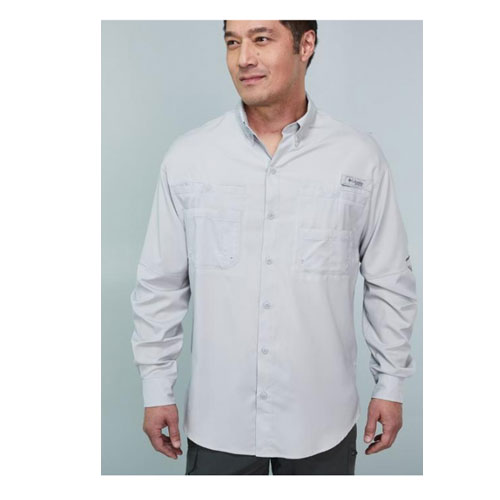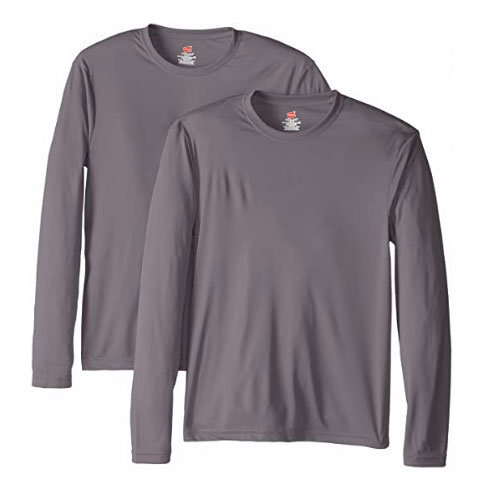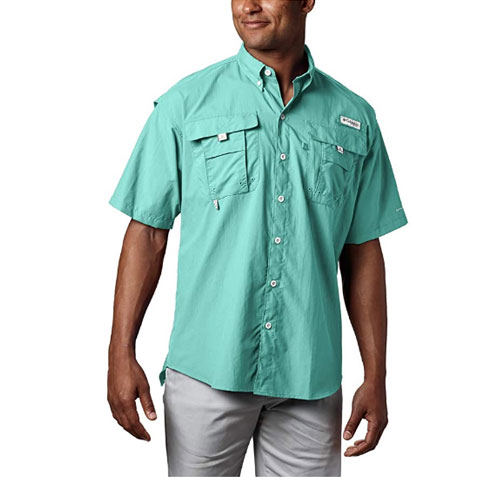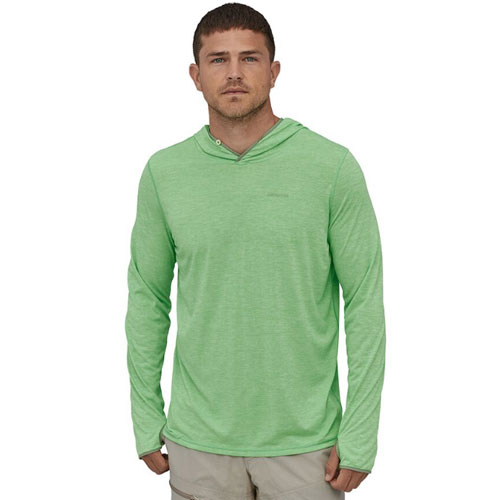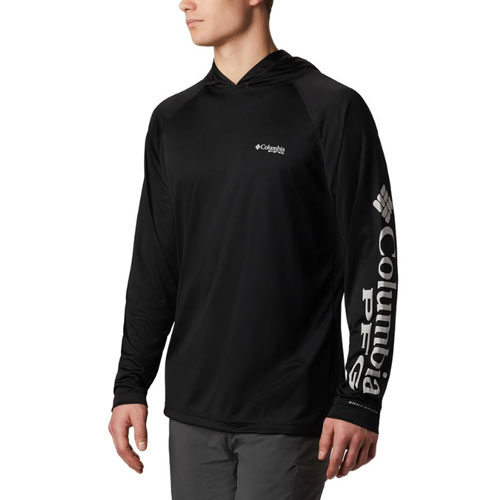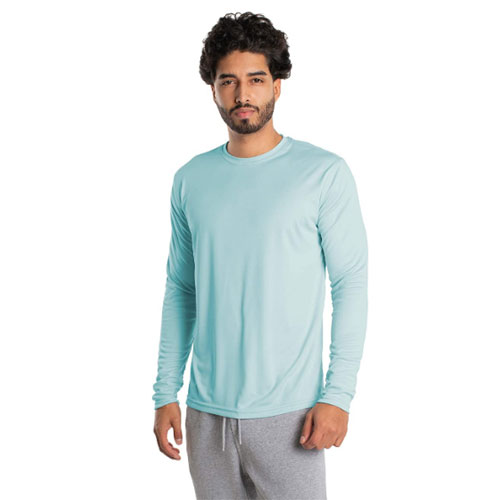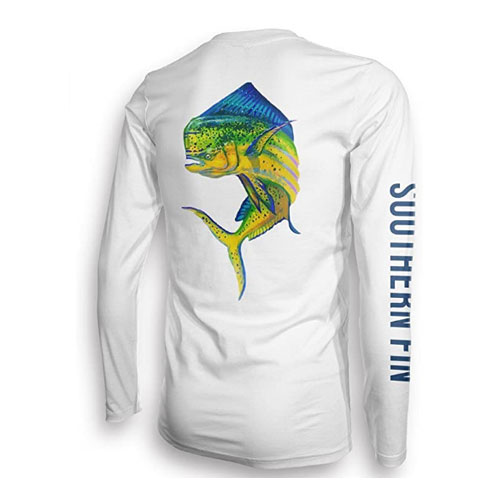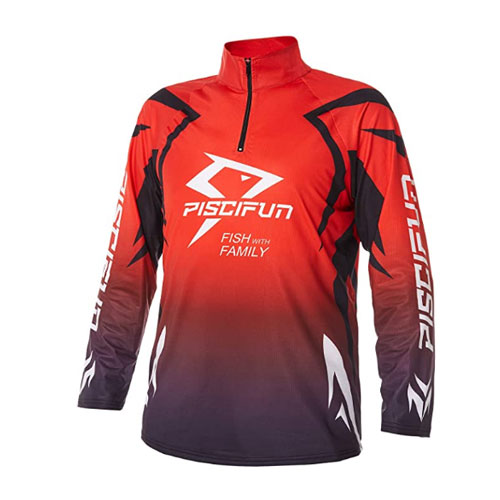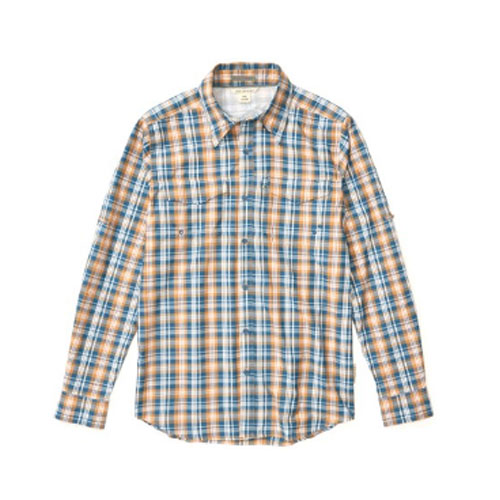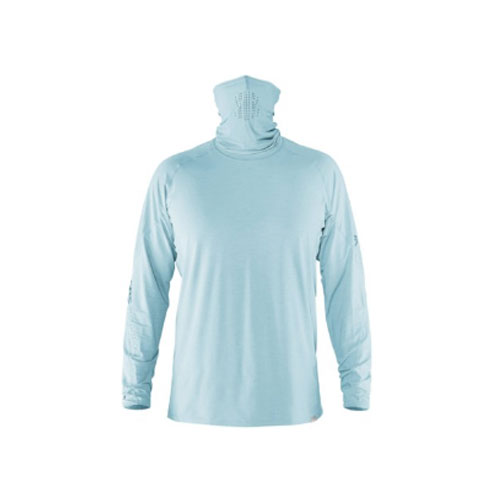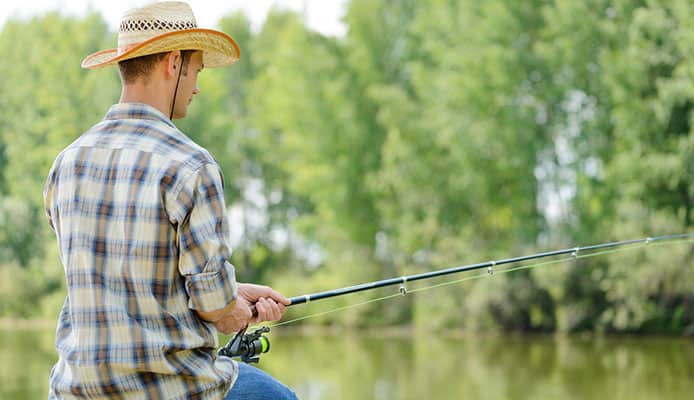
For a large number of anglers, fishing is most enjoyable in warm and sunny weather during the summer months. While this is undoubtedly fantastic, it also means that you’ll be exposed to direct sunlight, UV rays, changing humidity, and a lot of insects. So, if you want to fish in comfort without worrying about sunburns or nasty bites, you need to throw the best fishing shirt on your back.
The fishing shirt you buy needs to fit well, provide UV protection, feel comfortable to wear, and allow your skin to breathe. Since every angler has their own preference, a really large number of designs and styles can be found on the market. To help you choose, we have compiled a list of the best fishing shirts and T-shirts for every occasion. In addition, our buying guide will break down all the important features so you can easily figure out what works best for you.
OUR TOP PICK
Columbia PFG Tamiami II
- Stand Out Features - Why We Love It
- High-quality polyester fabric provides reliable sun protection (40 UPF)
- Antimicrobial treatment prevents the shirt from getting smelly
- Built-in vents allow your skin to breathe and improve the comfort
- Relaxed shirt fit allows you to move your arms without restrictions
- Several well-placed chest pockets for keeping valuables and essentials
- Button-closure tabs on the sleeves keep them in place when rolled up
Best For: Fishing and Hiking
Material(s): Polyester
Style: Button-Up
Sleeve Length: Long
Hood: No
UPF Rating: 40
Gender: Men’s
EDITORS CHOICE
Hanes Cool Dri
- Stand Out Features - Why We Love It
- Moisture-wicking Cool Dri fabric keeps you dry in the summer
- Blocks harmful UV rays from reaching your skin (UPF 50+)
- Lightweight and comfortable for wearing throughout the day
- Available in a large number of great-looking colors
- Long sleeves provide full arm protection in harsh weather
- Two shirts included in the package so you can change if needed
Best For: Lightweight Protection
Material(s): Polyester
Style: Long-Sleeve Shirt
Sleeve Length: Long
Hood: No
UPF Rating: 50+
Gender: Men’s
BEST VALUE
Columbia Bahama II Short Sleeve
- Stand Out Features - Why We Love It
- Hidden vents in the shoulders allow the shirt to breathe
- Omni-Shade fabric protects your skin from sunburns
- Chest pockets with Velcro closure for keeping small fishing gear
- Large number of sizes available (easy to find the right fit)
- High-quality nylon construction withstands frequent use
- Certified and recommended by the Skin Cancer Foundation
Best For: Warm Weather
Material(s): Nylon
Style: Button-Up
Sleeve Length: Short
Hood: No
UPF Rating: 30
Gender: Men’s
- Stand Out Features - Why We Love It
- Hooded shirt design for additional head and neck protection
- Polygiene anti-odor technology prevents nasty smells
- Thumbholes keep the sleeves in place while you’re active
- Ultralight polyester fabric feels fantastic in warm weather
- Wicks moisture efficiently and keeps you dry all day
- Relaxed fit gives you full freedom of movement when fishing
Best For: Head Protection
Material(s): Polyester
Style: Hoodie
Sleeve Length: Long
Hood: Yes
UPF Rating: 50
Gender: Men’s
Vapor Apparel Long Sleeve
- Stand Out Features - Why We Love It
- Lightweight microfiber construction with excellent breathability
- Set-In shoulder design significantly improves fit and comfort
- Pure-Tech Cool technology boosts moisture transport and elimination
- Microfiber fabric with reliable sunburn protection (50+ UPF)
- Shirt is recommended by the Skin Cancer Foundation
- Excellent for fishing, hiking, running, and many other sports
Best For: Breathability
Material(s): Microfiber Polyester
Style: Long-Sleeve Shirt
Sleeve Length: Long
Hood: No
UPF Rating: 50+
Gender: Men’s
Southern Fin Apparel Unisex
- Stand Out Features - Why We Love It
- Features great-looking prints on the sleeves and back
- Cool Tech fabric eliminates sweat and keeps your skin dry
- Fabric doesn’t get weaker or fade from sun exposure
- Relaxed fit makes wearing the shirt all day comfortable
- Unisex design fits both male and female anglers well
- Easy shirt maintenance (doesn’t shrink when machine-washed)
Best For: Humid Weather
Material(s): Microfiber
Style: Long-Sleeve Shirt
Sleeve Length: Long
Hood: No
UPF Rating: 50
Gender: Unisex
Piscifun Performance UPF
- Stand Out Features - Why We Love It
- High collar with a zipper provides additional neck protection
- Addition of spandex makes the shirt more flexible and comfortable
- Omni-Shade fabric filters out most of the harmful UV rays (UPF 30)
- Long sleeves give you full coverage on bright summer days
- Available in large sizes (up to 3XL) so everyone can find a good fit
- Great-looking print on the shirt easily stands out in the crowd
Best For: Fishing Comfort
Material(s): 90% Terylene, 10% Spandex
Style: Long-Sleeve Shirt
Sleeve Length: Long
Hood: No
UPF Rating: 30
Gender: Men’s
- Stand Out Features - Why We Love It
- Traditional plaid shirt design looks great for everyday wearing
- Vented yoke with mesh lining keeps you cool in high temperatures
- Two mesh-lined chest pockets with drain holes on the bottom
- Chamois patch in the bottom left placket for wiping sunglasses
- Flat-felled seams prevent chafing and improve comfort while wearing
- Utility loop on the front for securing your rod or hanging glasses
Best For: Everyday Wearing
Material(s): 59% Polyester, 41% Nylon Supplex
Style: Button-Up
Sleeve Length: Long
Hood: No
UPF Rating: 50
Gender: Men’s
- Stand Out Features - Why We Love It
- High turtleneck collar provides additional mouth and nose protection
- Laser-cut holes around the mouth and nose prevent glasses from fogging
- Small addition of spandex makes the shirt more elastic when moving
- Seamless shoulder and underarm design prevents chafing and discomfort
- Thumbhole cuffs keep the sleeves in place when lifting your arms
- Recycled polyester fabric with excellent sun protection (UPF 50+)
Best For: Nose and Mouth Protection
Material(s): Polyester
Style: Turtleneck
Sleeve Length: Long
Hood: No
UPF Rating: 50+
Gender: Men’s
How To Choose The Best Fishing Shirt – Buying Guide

Comfort
Comfortable attire is one of the most important things when you’re fishing in hot and humid conditions. You want a shirt that feels good on your skin and enables you to focus on casting and retrieving all day long. On the other hand, you want to avoid models that make you itchy and uncomfortable when it gets warm.
To make the right choice, you’ve got to consider how comfortable the fishing shirt is. Comfort in a fishing shirt depends on its other features such as the material used in its construction, how it is made, and how well it fits. Most of the best fishing shirts, especially ones made from microfiber, are very soft and feel good on the skin. They are also thin and lightweight.
A performance shirt should have minimal seams and lack scratchy tags at the back of the neck. This eliminates the risk of these rubbing the skin and causing irritating sensations and even rashes. A relaxed fit with room in the shoulders, arms, and torso, and a design that moves with you is also essential. Other must-have features for comfort in a fishing shirt include breathability/ventilation, moisture management, sun protection, and odor prevention.
Fit
A fishing shirt should have a relaxed fit – not too tight that it’s uncomfortable and you can’t move freely, but not too baggy that it gets in the way of your fishing motions. The best fishing shirts feature a roomy cut to offer a relaxed fit that’s optimal for fishing comfort and performance.
Room in the shoulders, arms, and torso, as well as a flexible fit that moves with you, allow for a free range of movement so you can freely swing your arms when casting and reeling. A roomy fit also shades the skin, promotes free airflow through the shirt, and allows sweat to evaporate keeping you cool and dry.
To determine what size to order, look at the brand’s sizing guide, as fishing shirt sizes are not standardized and fit differs from manufacturer to manufacturer. Reading user reviews will also give you an idea as to whether a shirt fits true to size or runs smaller or bigger.
Pay attention to a shirt’s back length, sleeve length, and armpit design. The shirt shouldn’t be too long that you have to keep adjusting it or too short that it keeps bunching and coming untucked.
Materials
The material a fishing shirt is made of is a very important consideration as it determines how comfortable it feels, how protective it is, and how long it lasts. The best fishing shirt for hot weather is one made from a lightweight, breathable, and moisture-wicking material that feels good on the skin. Here are some of the typical materials used for fishing shirts along with their pros and cons.
Polyester – Polyester is a synthetic fabric that offers the best fishing experience on a hot sunny day. Microfiber performance fishing shirts composed of polyester are super-soft and very comfortable.
- Advantages: It offers superior protection from cold, wind, and UV rays. It repels water and dries fast. It’s lightweight, soft, and feels comfortable on the skin. It has great breathability, wicks moisture, and resists odors. It isn’t affected by mold and insects. It is durable and easy to care for.
- Disadvantages: It develops static electricity and attracts dirt. It’s less resistant to abrasion than nylon.
Nylon – A synthetic fabric with excellent durability and abrasion resistance. It’s tougher than polyester and provides better protection but it’s also a bit heavier.
- Advantages: Its woven strands make it strong and durable with excellent abrasion resistance, wear, and shedding. It’s thin, lightweight, quick-drying, smooth, and feels good on the skin. It can easily be made bugproof and windproof. It’s inexpensive and has good UV shielding properties.
- Disadvantages: Nylon’s biggest weakness as a fishing shirt material is that it doesn’t allow air to circulate. It also attracts static dirt and can cause skin allergies.
Cotton – While cotton does offer some advantages over synthetic materials, it doesn’t perform as well in warm or hot weather. On the other hand, cotton fishing shirts are a good choice for colder weather.
- Advantages: It has excellent breathability and allows air to circulate freely. It feels comfortable on the skin. It resists high temperatures. It is easy to wash and doesn’t require special care.
- Disadvantages: Its biggest weakness is that it doesn’t wick away moisture but absorbs it and gets soggy and heavy from your sweat. It gets dirty easily and the dirt embeds deep into the fibers. It also dries slowly compared to synthetic materials.
Sun Protection
To determine how much protection a shirt offers, check its UPF rating. UPF (Ultraviolet Protection Factor) is a measure of UV protection in fishing shirts. A sun protection fishing shirt should have a UPF rating of at least 30+. The highest rating is UPF 50+, which blocks 49 out of each 50 rays offering protection from 98% of the sun’s harmful rays.
Some shirts block not just UVA rays but also UVB rays, which are the most harmful and present even when the sun is behind the clouds. Other shirts are treated with UV reflectors and UV absorbers. Washing may reduce these treatments but the best shirts have UV protection built into the fabric so it doesn’t wear out.
Other factors in a fishing shirt that help protect your skin against sunburn and the harmful effects of prolonged exposure to UV rays include a tightly woven fabric so the sun’s rays can’t penetrate, long sleeves, high necklines, and dark blues and reds colors. Nylon and polyester offer the best sun protection, as they have UV reflecting qualities.
Warm and bright sunny days are perfect for fishing but this means being directly under the harmful sun’s rays for hours at a time. Prolonged and repeated exposure to the sun without protective clothing increases the risk of skin damage. When fishing under the blazing sun, a fishing shirt that protects your torso and arms from the sun’s harmful UV rays is a must-have.
Odor Prevention
Casting and retrieving for hours is an intense workout. This, in combination with sunlight and high temperatures, results in you getting sweaty. On top of this, your fishing shirt will also be exposed to all kinds of fishy odors.
The best fishing shirts have anti-microbial properties to inhibit the growth of bacteria responsible for the development of odors. This ensures the shirt doesn’t develop stubborn and offensive odors but keeps smelling fresh even with prolonged wear when fishing in the heat.
A fishing shirt fabric with moisture-wicking qualities that promote the evaporation of sweat also keeps odor development at bay.
Stain Resistance
When it comes to fishing, stains are something very common. Your fishing shirt will be splashed and splattered with all kinds of stains from dirty water to fish slime and guts. For this reason, you want your fishing shirt to have the ability to resist staining.
Some shirts have the fabric treated for stain resistance and sealed to prevent permanent stains. On top of this, some even come with a stain release treatment so the stains come off more easily when washing.
Weight
A thin, lightweight fishing shirt is the most comfortable piece of clothing to wear when fishing, especially in warm weather. This type of shirt doesn’t weigh you down, or hinder your movements when casting your bait. On the other hand, a thicker and heavier shirt might be less comfortable but still makes a pretty good option in cold weather.
Color and Design
The choice of color and print is largely a matter of personal preference, and it’s natural to gravitate towards shirts with designs that you like. In addition to style, color in a fishing shirt also determines its ability to block ultraviolet rays and keep you cool.
The darker your shirt is, the more sunlight it will absorb which means it will retain heat and make you hot. On the other hand, shades of red and blue have been found to effectively block the sun’s UVB rays from getting to the skin. The darker and more intense the shades, the better the protection. Light colors reflect sunlight and help keep you cool. However, they do not protect you from ultraviolet radiation.
As for the design, we feel that a shirt with multiple easy-access pockets and loops is very convenient when fishing. It allows you to keep the most important items on your body and quickly grab them when you need them. Furthermore, long sleeves and adjustable neckline/collar are a big plus when it comes to sun protection.
Drying Speed
Fishing shirts are bound to get wet in one way or another. Whether you sweat, get splashed on, rained on, or accidentally tumble into the water, you’ll want your fishing shirt to dry quickly instead of turning into a soggy mess. Here are a few factors that determine moisture management:
- Dark colors absorb heat and boost evaporation
- Thin fabrics absorb less water and dry faster
- Synthetic polyester and nylon fabrics dry much faster than natural cotton
- Some shirts are treated with water-repelling coatings
Another factor that contributes to a shirt’s drying ability is its moisture-wicking properties. A fishing shirt composed of a fabric and inner lining with moisture-wicking properties works really well in humid environments and effectively removes the sweat from your skin so you can stay perfectly dry and comfortable.
Breathability
A breathable fishing shirt with moisture-wicking ability allows free circulation of air and promotes rapid evaporation of sweat. It moves sweat away from the skin and allows your skin to breathe keeping you dry, cool, and comfortable. Thanks to this, you can fully enjoy fishing regardless of the heat, sweat, and humidity.
Polyester is probably the best option when it comes to breathability, as it has great moisture-wicking properties and allows plenty of air movement. Cotton has very good breathability too, but tends to absorb sweat instead of letting it evaporate. As for nylon, ventilation and breathability is a major issue.
For improved air circulation, many models we’ve featured come with ventilation panels on the back and in the shoulder area. They guarantee a good airflow and improve cooling where it is needed the most. On top of this, mesh or soft fabric lining on the interior of fishing shirts helps with removing the sweat off the skin.
FAQs
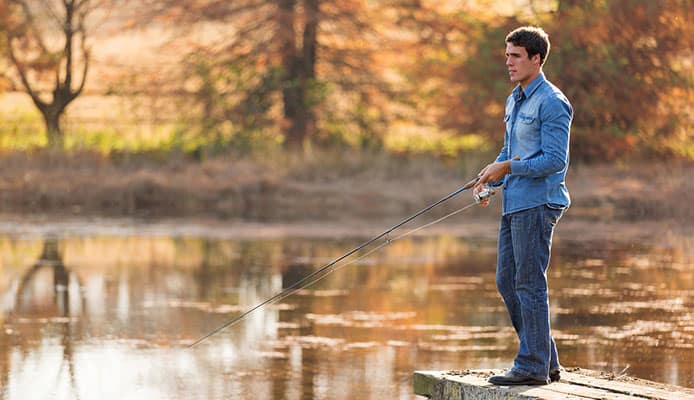
Q: How Long Should A Performance Shirt Last?
The durability of your performance shirt depends on the materials, maintenance, how often it’s worn, and the level of sun and saltwater exposure. Performance shirts are just like other clothes and they will wear out over time. The higher the construction quality, the longer a performance shirt will last.
This being said, the best performance shirts are made to last for several seasons with a normal amount of use. They are constructed using tough fabrics, feature strong stitching, a sublimated dye that doesn’t fade or crack, and other treatments that enhance damage-resistance.
Q: How Should Fishing Shirts Fit?
Since fishing is a relaxed activity, fishing shirts need to have a fit to match. Unlike compression sportswear or swimming rashguards that fit tight, fishing shirts should have a relaxed fit.
This results in a high level of comfort and allows freedom of movement when casting and reeling. Too tight and the shirt will be uncomfortable, while a shirt that is too loose will get in the way. A slightly baggy and longer fit also shades the skin more effectively and allows air to flow freely so you can stay cool.
Q: Are All Fishing Shirts Waterproof?
No, fishing shirts are usually not waterproof meaning that you can’t dive in and stay dry. However, almost all fishing shirts are made from quick-drying materials like polyester and nylon, so they will dry off quickly if you accidentally get wet. In addition, some models feature water-repellent coating on the surface that prevents the shirt from getting soaked from splashing.
While you won’t get completely wet when fishing, heat, humidity, and sweat are the major issues you will encounter. Because of this, the shirt must be breathable so it can release moisture and keep you dry and comfortable. Waterproofing would hinder this function and make the shirt very uncomfortable because you would be soaked in your own sweat.
Q: What Makes A Great Fishing Shirt?
The most important thing in a great fishing shirt is a lightweight fabric construction that feels good, allows your skin to breathe, and wicks moisture so you can stay cool and dry. The fabric should also dry quickly and be easy to maintain. In addition, the fishing shirt should also have a high UPF rating so it can protect you from sunburns.
Q: What Is The Difference Between UPF And SPF?
Both the UPF (Ultraviolet Protection Factor) and the SPF (Sun Protection Factor) represent sun protection measurement standards.
SPF indicates the duration it takes for the skin to burn when exposed to sunlight. The higher the SPF number, the longer it takes. This protection measurement is a standard for cosmetics, sunscreens, and sunglasses.
UPF is a measure of the UV resistance that a piece of fabric provides. It indicates how much of the ultraviolet radiation a fabric can block and, subsequently, the amount that penetrates through it and reaches the skin. For example, a fabric with a 50+ UPF rating blocks 49 out of each 50 rays and provides 98% UV protection.
The Skin Cancer Foundation gives its seal of approval to sun-protective fabrics with a minimum UPF of 30. Fabrics with 30-49 UPF are considered as very good protection and 50+ as excellent protection.
Q: Is it Better To Wear Long Sleeves or Short Sleeves?
This mostly comes down to personal preference. Some people prefer long sleeves to cover and shield their forearms from the sun, while others prefer the convenience that short sleeves offer as well as the opportunity to tan. Both sleeve lengths have their pros and cons. Generally speaking, a lightweight shirt with long sleeves is the best option for summer days with plenty of sunlight because it will give you the best UV protection and prevent sunburns.
Globo Surf Overview
Every avid angler knows that the clothing they wear is just as important as all the other parts of the fishing gear. This all starts with a well-made shirt, and the best fishing shirts offer a combination of performance, style, and reliable protection regardless of the weather conditions. Hopefully, our guide and reviews have pointed you in the right direction and helped you find the best fishing shirt so you can always dress for fishing success.
More Fishing Apparel Reviews:
- Fishing Shorts
- Fishing Boots
- Waders For Women
- Hip Waders
- Boonie Hats
- Fishing Gloves
- Fishing Vests
- Fishing Jackets
What is your go-to fishing shirt? Do you own any of the fishing shirts in our list? How is its performance? We’d love to hear from you! Share in the comment box below.



